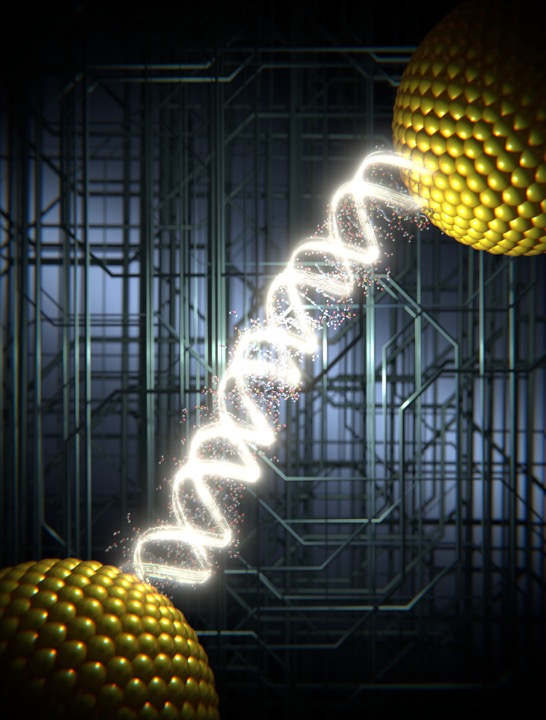Backbone DNA conduction
17/08/20 18:20
The understanding of the charge transport in DNA molecules continues to be an open problem of fundamental importance for different disciplines such as biology, chemistry, physics, and electrical engineering. It is also very relevant from a technological point of view due to DNA’s ability to form versatile and complex programmable structures. Charge transport in DNA-based junctions has been a central topic in Nanotechnology for more than two decades and numerous experiments have been reported using a great variety of setups. Those experiments have yielded seemingly contradictory results that range from insulating to metallic behavior. As a consequence, the intrinsic charge transport mechanism in long DNA molecules is still not very well understood. The key problem so far has been that there is no experimental technique which is capable of simultaneously: (i) contact individual, suspended long DNA molecules with the electrodes, (ii) validate their presence between the electrodes, and (iii) form junctions stable enough to allow reproducible conductance measurements at different temperatures, which essential to elucidate the transport mechanism in any nanoscale device.
Now, we have overcome this hurdle in a work published in Nature Nanotechnology by a collaboration between groups of the Hebrew University of Jerusalem, Tel Aviv University, Weizmann Institute of Science (Rehovot), the University of Cyprus (Nicosia), the University of Michigan, the University of Seville, and myself. In this work, we reported charge transport measurements through single 30 nm-long double-stranded (ds)DNA molecules with a novel experimental setup that enables to address individual molecules repeatedly and to measure the current-voltage characteristics from 5 K up to room temperature. In this technique developed in Danny Porath's lab, individual dsDNA molecules connected to two gold nanoparticles are first synthesized (in Alexander Kotlyar's lab). Then, these “dimers” are trapped by dielectrophoresis between lithographically patterned nanoelectrodes to form the DNA junctions. Finally, and after the electrical characterization of the devices, scanning electron microscopy is used to confirm the presence of a single dimer structure bridging the gap between the metallic electrodes.
Using this technique, we reported very high currents of tens of nanoamperes in both homogeneous and non-homogeneous base-pair sequences. The currents were found to be fairly temperature independent in the range of 5-60 K and showed a power-law decrease with temperature above 60 K, which is reminiscent of charge transport in organic crystals. More importantly, it was shown that the presence of even a single discontinuity (“nick”) in both strands composing the dsDNA leads to complete suppression of the current. This suggests that the backbones mediate the long-distance conduction in dsDNA, contrary to the common wisdom in DNA electronics. Our extensive molecular dynamics simulations and state-of-the-art electronic structure calculations based on density functional theory (DFT) supported the idea of backbone conduction and strongly suggested that the charge transport is dominated by an incoherent mechanism involving hopping between localized molecular orbitals.

Now, we have overcome this hurdle in a work published in Nature Nanotechnology by a collaboration between groups of the Hebrew University of Jerusalem, Tel Aviv University, Weizmann Institute of Science (Rehovot), the University of Cyprus (Nicosia), the University of Michigan, the University of Seville, and myself. In this work, we reported charge transport measurements through single 30 nm-long double-stranded (ds)DNA molecules with a novel experimental setup that enables to address individual molecules repeatedly and to measure the current-voltage characteristics from 5 K up to room temperature. In this technique developed in Danny Porath's lab, individual dsDNA molecules connected to two gold nanoparticles are first synthesized (in Alexander Kotlyar's lab). Then, these “dimers” are trapped by dielectrophoresis between lithographically patterned nanoelectrodes to form the DNA junctions. Finally, and after the electrical characterization of the devices, scanning electron microscopy is used to confirm the presence of a single dimer structure bridging the gap between the metallic electrodes.
Using this technique, we reported very high currents of tens of nanoamperes in both homogeneous and non-homogeneous base-pair sequences. The currents were found to be fairly temperature independent in the range of 5-60 K and showed a power-law decrease with temperature above 60 K, which is reminiscent of charge transport in organic crystals. More importantly, it was shown that the presence of even a single discontinuity (“nick”) in both strands composing the dsDNA leads to complete suppression of the current. This suggests that the backbones mediate the long-distance conduction in dsDNA, contrary to the common wisdom in DNA electronics. Our extensive molecular dynamics simulations and state-of-the-art electronic structure calculations based on density functional theory (DFT) supported the idea of backbone conduction and strongly suggested that the charge transport is dominated by an incoherent mechanism involving hopping between localized molecular orbitals.

